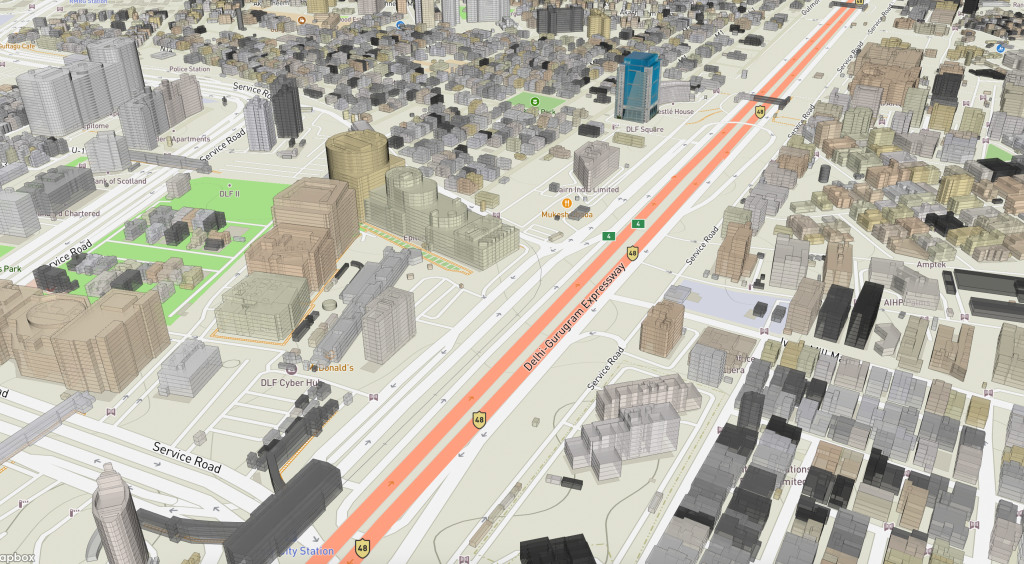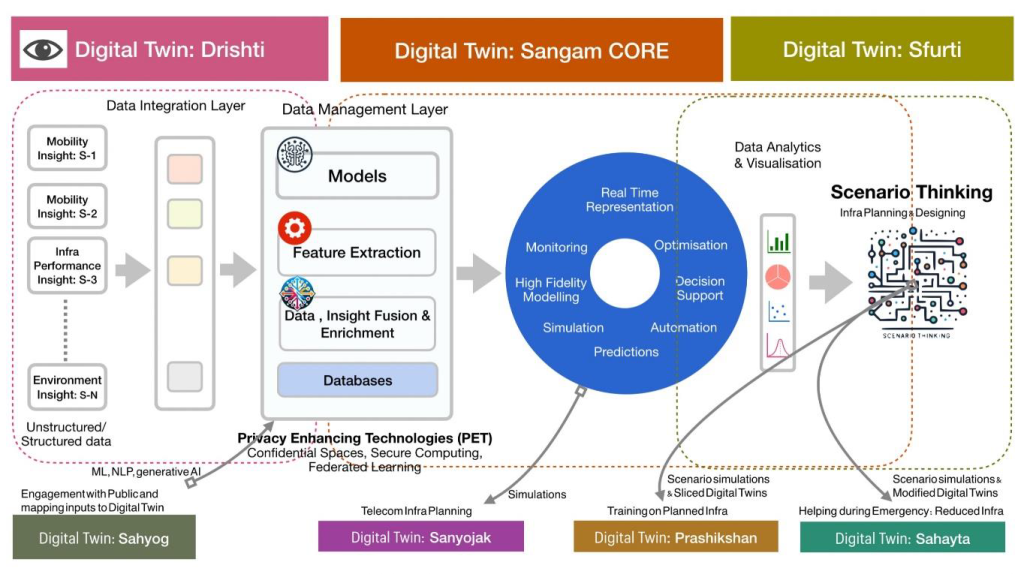Think Tank
Power of Digital Twin – Reimagining infrastructure planning and urban development

India has experienced remarkable transformations in its infrastructure sector, propelled by major push from the government. These efforts have modernized highways and railways and revitalized waterways, heralding a period of substantial growth in infrastructure development.
This growth has facilitated unprecedented national connectivity, positioning the infrastructure sector as a critical force in driving the Indian economy forward. The key to sustaining this success lies in the effective planning, execution, and management of forward-looking infrastructure projects.
The 2023-24 budget boosted infrastructure capital investment by 33 percent to Rs 10 lakh crore (around USD 122 billion), about 3.3 percent of GDP, nearly tripling the 2019-20 figure. The 2024 Interim Budget further increased this to Rs 11.11 lakh crore for FY 2025.
India’s metro expansion has transformed urban transport, now holding the fifth-largest global network and set to overtake Japan and South Korea for the third spot. Metro rail network reached 810 km and is operational in 20 cities as of September 2022.
India’s road and highway sector has seen remarkable growth, building over 55,000 kilometers of highways in the past decade. Construction pace has surged from 12 kilometers per day in 2014-15 to approximately 29 kilometers per day in 2021-22.
Addressing a webinar on Urban Planning, Development, and Sanitation, Prime Minister Narendra Modi underlined “It is important to build infrastructure that is futuristic” and emphasized that the government’s vision is the development of new smart cities and to upgrade the facilities of old cities.”
As per World Bank, globally, over 50 percent of the population lives in urban areas. By 2045, the world’s urban population will increase by 1.5 times to 6 billion.
Digital twin technology is a ground-breaking solution that is revolutionizing the way the infrastructure is rolled out. This offers a comprehensive and dynamic solution for design, construction, and efficient management.
Digital twin technology creates virtual models of physical assets, processes, or systems, integrating real-time data for behavior modelling. These digital twins facilitate real-time monitoring, analysis, and optimization, enhancing operational efficiency, informed decision-making, and streamlining project lifecycles, potentially leading to significant cost savings. The technologies of artificial intelligence (AI), the internet of things (IoT), metaverse, and virtual and augmented reality (VR/AR) are combined to produce digital models (digital twins). These models allow for cost-effective simulation and analysis of the impact of modifying various parameters on the twinned entity, as opposed to conducting real-world experiment.
Digital twin of Gurugram

Courtesy: Lepton Software
Before the advent of digital twins, infrastructure planning often suffered from a siloed approach, resulting in inefficiencies and drawbacks. There was limited information sharing among departments or organizations involved in infrastructure projects (e.g., transportation, utilities, construction). Typically, each operated with their own data and tools, creating information silos. This hindered collaboration and impeded a holistic view of the project. Disconnected planning among departments led to potential conflicts and unforeseen challenges during construction or operation. Without a unified view of the entire infrastructure system, it was challenging to identify and implement optimizations. The lack of coordination and communication due to silos could lead to project delays, cost overruns, and rework due to unforeseen issues arising from disconnected planning. Siloed planning limited the potential for innovation.
Digital twins emerged as a potential solution to these issues by creating centralized, interconnected platform that integrates data from various sources and stakeholders. Digital twins are encouraging a shift toward a more integrated and collaborative approach to infrastructure planning.
Digital twin technology has diverse applications across various sectors. However, some leading global examples showcase the immense potential of digital twins in infrastructure and urban development.
Singapore’s City of the Future Virtual Singapore is an ambitious project that aims to create a digital twin of the entire city-state, encompassing buildings, infrastructure, and even environmental data. This allows for real-time monitoring, resource optimization, and improved urban planning.
The project started in 2014 by the Singapore government aimed at creating a highly detailed and accurate virtual replica of the city-state of Singapore. Virtual Singapore seeks to revolutionize urban planning, infrastructure management, and decision-making processes through advanced digital modelling and simulation technologies.
The project was officially launched with an initial investment of SGD 73 million (approximately USD 54 million) over five years. This funding was provided by the Singapore government through the National Research Foundation (NRF) and the Singapore Land Authority (SLA). Since its inception, the project has continued to receive additional funding and support from various government agencies, research institutions, and industry partners to further develop and expand its capabilities.
The digital twin of Singapore is built using advanced 3D modelling and visualization techniques. This includes creating detailed 3D models of buildings, terrain, roads, bridges, and other infrastructure elements with high levels of accuracy and realism. The models are continuously updated to reflect changes in the physical environment, such as new construction projects or urban developments.
Virtual Singapore enables urban planners, policymakers, and researchers to simulate and analyze various urban scenarios in a virtual environment. This includes scenarios related to land use planning, transportation management, disaster response, environmental sustainability, and public safety. By running simulations within Virtual Singapore, stakeholders can assess the potential impacts of different policies, projects, and interventions before implementing them in the real world.
As part of its pioneering initiatives, the Department of Telecommunications (DoT) has come out with a ground-breaking Sangam: Digital Twin initiative, a proof of concept (PoC) aimed at revolutionizing infrastructure planning and design and implementation by leveraging the power of digital twin and harnessing the power of evolving technologies, including AI, ML, and IoT. At the core of this endeavor lies the fusion of digital twin technology with comprehensive mobility insights, real-time data collection from diverse sources breaking silos, prominently including crucial insights from the telecommunications sector.
The Digital Twin: Sangam initiative encompasses three key components: Drishti, Sfurti, and Sanchar Sanyojak. Drishti focuses on monitoring visitor movements and behavior within the event space, employing sensors and data analytics to optimize layout and enhance security measures. Sfurti showcases the adaptability of event infrastructure, utilizing IoT and automation to swiftly reconfigure setups in response to changing requirements. Sanchar Sanyojak ensures seamless connectivity by creating a digital twin of telecom networks, optimizing performance to provide reliable communication for all participants. Together, these components aim to streamline event management, enhance attendee experience, and facilitate efficient resource utilization.
Pictorial representation of Digital Twin

Courtesy: EOI published by Department of Telecom on Feb 15, 2024
Sangam digital twin is a two-stage program, inviting expressions of interest (EoI) from industry stakeholders. Proof of concept ( PoC ) is distributed in two stages to be conducted in one of the major cities of India.
First stage. This stage explores the potential of digital twins in infrastructure planning. It involves brainstorming, creative exploration, and defining the scope of the project.
Second stage. This is for practical implementation of specific use cases generating a future blueprint that may serve as a roadmap to scale and replicate successful strategies in future infrastructure projects through collaboration.
ITU has come out with Recommendation ITU-T Y.3090 Digital twin network (DTN) – Requirements and architecture. The scope of this recommendation includes the functional requirements, service requirements, architecture, and security considerations of DTN.
Some of the key feature of the Sangam digital twin project are:
- Transform infrastructure planning. Effectively use digital twin technology for efficient planning, design, and management of infrastructure projects including roll out of metros, building highways, city development, large events management, etc.
- Leveraging cutting-edge technologies. Sangam shall utilize various technologies alongside digital twins, including 5G, Internet of Things (IoT), artificial intelligence (AI), augmented reality/virtual reality (AR/VR), and next-generation computational technologies.
- Boost innovation. Facilitate the creation of innovative and sustainable infrastructure solutions.
- Collaborative approach. Bring together public entities, private companies, academia, MSMES, and innovators to work on infrastructure and smart city’s development challenges.
- Demonstrate value. Showcase the use cases of digital twin technology in infrastructure development.
- Special focus on event management. While the broader PoC targets infrastructure planning and design, it also includes focus on using digital twins for large-scale event management, highlighting the potential of data-driven insights for improving attendee experience and reducing infrastructure strain.
The PoC approach envisages collaboration among various stakeholders bringing competence in areas like geospatial technology, AI/ML edge computing, IOT, analytics, immersive technologies, 3D modelling, etc. Experts are required to work closely to effectively integrate and manage data within a connected common data environment and address the risks of interdisciplinary integration.
For the PoC to succeed, it is crucial to integrate lessons from globally experienced collaborative digital twin projects. Starting with a light-touch approach, demonstrating value on a small scale before scaling up, is advisable. Focusing on a few key use cases initially, such as route optimization for new infrastructure projects, real-time analysis of cellular networks at large events like Kumbh, or simulating the impact of infrastructure projects is prudent. Several companies in India offer digital twin solutions, including Lepton Software for high-resolution 3D maps, NetworkAccess and SmartSignal for telecom, and BlueSky Analytics for climate change modelling. Other players also offer complementary solutions for digital twins.
It may be judicious to choose use cases with readily available geospatial data, currently available at 1–2 meter accuracy at large scale instead of focusing on building sub-meter or centimeter-level accurate geospatial data as there are very few use cases to support such high-resolution data. Aerial photos or LIDAR-based data extraction could be avoided in the initial stage. Aerial photos or LIDAR technology can indeed add complexity to the process of building a digital twin of a city, both in terms of data acquisition and processing. While these technologies can provide highly detailed and accurate 3D representations of urban environments, it may not always be necessary or practical, especially in the context of a light-touch approach where simplicity and efficiency are key considerations. It also gets extremely challenging to manage these datasets in context of India where the urban environments are changing rapidly.
In view of the great infrastructure push from the government, Sangam digital twin PoC presents a unique opportunity for India to leverage digital technology and collaboration to transform its infrastructure development process. It is a great initiative by the DoT.
Globally, digital twin market category is growing fast. Sangam consortium approach can play an important role in showcasing commercial adoption of the technology for real-time infrastructure projects in the Indian context, which can be further replicated in other markets.
The article is authored by Sanjeev Kakkar, a Telecom Expert. He has held various CXO level positions in technology companies. Views expressed are personal.















You must be logged in to post a comment Login